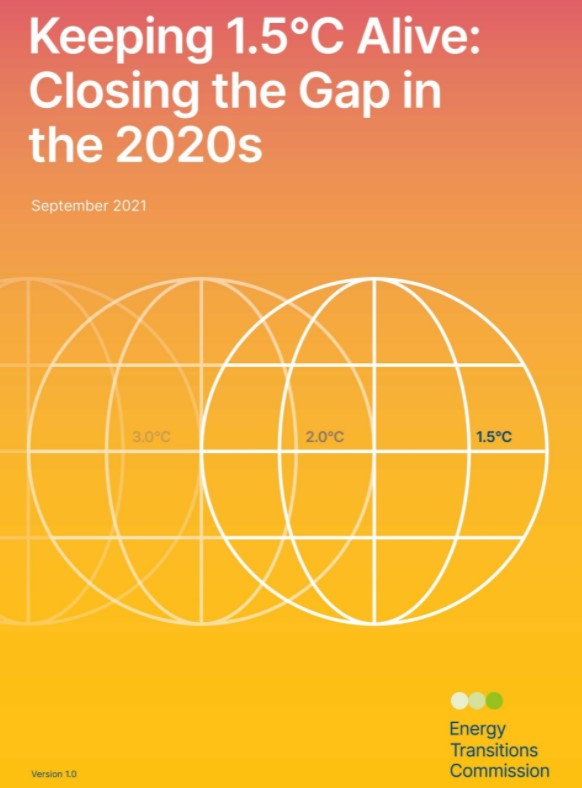Keeping 1.5°C Alive: Closing the Gap in the 2020s

|
Contents |
[edit] Introduction
On 30 September 2021, the Energy Transitions Commission (ETC) set out the actions which nations and companies could take during the 2020s to deliver the Paris agreement and limit global warming to 1.5°C. The ETC is a global coalition of leaders from across the energy landscape committed to achieving net zero emissions by the middle of the century.
[edit] Six action items
Keeping 1.5°C Alive: Closing the Gap in the 2020s describes technologically feasible actions which could close the gap created by national decarbonisation pledges (known as Nationally Determined Contributions, or NDCs) that fall short of those needed to prevent global warming from exceeding 1.5°C above pre-industrial levels. An additional 17-20 Gt of CO2 reductions and a 40% reduction in methane emissions would be needed to achieve that objective.
The six categories of action identified by the ETC are:
- Significant and rapid reductions in methane emissions.
- Halting deforestation and beginning reforestation.
- Decarbonising the power sector and accelerating the phaseout of coal.
- Accelerating the electrification of road transport.
- Accelerating supply decarbonisation in buildings, heavy industry, and heavy transport.
- Reinvigorating energy and resource efficiency.
The actions in the report might be achievable with minimal cost, and their adoption could spur further innovation and support green economic development. All six of the actions could be given impetus at COP26 via commitments from leading countries and companies without the need for comprehensive international agreement. However, two high priority actions – ending deforestation and reducing emissions from existing coal plants – will require support from climate finance flows from rich developed countries.
[edit] Related articles
- Climate Change Act.
- Decarbonise.
- Economic development and construction.
- Forests.
- Methane.
- Nationally Determined Contribution.
[edit] External resources
Featured articles and news
Government consultations for the summer of 2025
A year of Labour, past and present consultations on the environment, the built environment, training and tax.
CMA competitiveness probe of major housing developers
100 million affordable housing contributions committed with further consultation published.
Homes England supports Greencore Homes
42 new build affordable sustainable homes in Oxfordshire.
Zero carbon social housing: unlocking brownfield potential
Seven ZEDpod strategies for brownfield housing success.
CIOB report; a blueprint for SDGs and the built environment
Pairing the Sustainable Development Goals with projects.
Types, tests, standards and fires relating to external cladding
Brief descriptions with an extensive list of fires for review.
Latest Build UK Building Safety Regime explainer published
Key elements in one short, now updated document.
UKGBC launch the UK Climate Resilience Roadmap
First guidance of its kind on direct climate impacts for the built environment and how it can adapt.
CLC Health, Safety and Wellbeing Strategy 2025
Launched by the Minister for Industry to look at fatalities on site, improving mental health and other issues.
One of the most impressive Victorian architects. Book review.
Common Assessment Standard now with building safety
New CAS update now includes mandatory building safety questions.
RTPI leader to become new CIOB Chief Executive Officer
Dr Victoria Hills MRTPI, FICE to take over after Caroline Gumble’s departure.
Social and affordable housing, a long term plan for delivery
The “Delivering a Decade of Renewal for Social and Affordable Housing” strategy sets out future path.
A change to adoptive architecture
Effects of global weather warming on architectural detailing, material choice and human interaction.
The proposed publicly owned and backed subsidiary of Homes England, to facilitate new homes.
How big is the problem and what can we do to mitigate the effects?
Overheating guidance and tools for building designers
A number of cool guides to help with the heat.
The UK's Modern Industrial Strategy: A 10 year plan
Previous consultation criticism, current key elements and general support with some persisting reservations.
Building Safety Regulator reforms
New roles, new staff and a new fast track service pave the way for a single construction regulator.
























